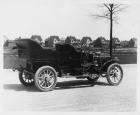|
Re: Engine Code Questions
|
||||
|---|---|---|---|---|
|
Home away from home
|
Bob J
I did some digging on the web and found this: I was visting with a local small performance engine builder yesterday to check out his flow bench and while there asked him if he knew what the "Casting Clock" means. He said yes, as a matter of fact he did. He explained that he knows an owner of an aluminum foundry and posed the same question of him at one time. The foundry owner told him that it refers to the bulk number of mold forming cycles that that particular pattern has made in the foundry. One of the functions of the clock is to identify when it needs to be returned to the pattern shop for routine maintenance. Another may be for help in identifing castings during quality control problems, and I suppose this could actually be its sole purpose. Supposedly the patterns wear during use from the abbrasiveness of the sand, thus altering the thickness of the casting. The clock helps identify a basic point in the patterns cycle life when it was used to make a casting mold. Evidently it is quite common to use other marks for this as well, like a line of dots, which is what this foundry owner uses. It would be interesting to know approximately how many units are represented by each dot or number. The DIF castings I have (or the ones I have looked at) show 7 dots, whereas the MCC castings show the numbered clock with the five odd numbers. I suppose its possible that since all the foundries were a little different that the clock may represent a different number of units depending on where it was cast. I've read that in the 20's that they would cast as many as 10,000 Model T blocks in a day at DIF. They sure didn't mess around!! It would be interesting to know what the average number of FE's cast in a day was by foundry. The rest is here, fordfe.com/casting-clock-possible-explaination-t11904.html dp
Posted on: 2023/5/6 14:41
|
|||
|
||||
|
Re: Engine Code Questions
|
||||
|---|---|---|---|---|
|
Home away from home
|
Interesting and I've always wondered the same thing. The Packard in question here must be custom due to the green engine and painted head lettering (the engine should be grey) so I wonder how custom it is or if it's only a matter of color choices.
Posted on: 2023/5/6 15:30
|
|||
|
All generalities are false.
Once I thought I was wrong but I was mistaken. Don Pierson Packard / IMPERIAL page CA DMV Licensed Vehicle VIN Verification 1951 Henney-Packard 3-Door Long Wheelbase Air Force Ambulance The 1951 Henney-Packard is For Sale! 1954 Packard Patrician 1954 Packard Patrician Parts Car 1956 Clipper Custom Sedan |
||||
|
||||
|
Re: Engine Code Questions
|
||||
|---|---|---|---|---|
|
Home away from home
|
Thanks David so much for the info. I work with plastic moulded part tooling so we have date codes that show the year in the centre then rotate around for each of the 12 months and you are correct, it is for standards testing and quarantine purposes in case of issues with a given run.
I have done some aluminum part casting work for clients and I believe the graphite tools used are good for about 10,000 parts before they need dressing in the tool shop so I am sure your clock data to let the mould shop know its time between rework is spot on. Thanks. Yes Don, it is 'custom' in a way as it is all original, but came out of, and going back into, my '37. The owner before me swapped out the 282 back in the 50's and it is a far superior mill so I agree with the update. I like the green, so that is why it is that colour. You are quite correct, it was of course grey to start with. Bob J.
Posted on: 2023/5/6 15:48
|
|||
|
||||
|
Re: Engine Code Questions
|
||||
|---|---|---|---|---|
|
Home away from home
|
Thank you, Bob, for clarifying. Of course, for 1937 it should be green although different shade to what you have but is probably fairly close to the color I originally painted my 1940 110 engine when it was rebuilt in the '60s. It was a shake can from the hardware store and called Forest Green.
Posted on: 2023/5/7 0:57
|
|||
|
All generalities are false.
Once I thought I was wrong but I was mistaken. Don Pierson Packard / IMPERIAL page CA DMV Licensed Vehicle VIN Verification 1951 Henney-Packard 3-Door Long Wheelbase Air Force Ambulance The 1951 Henney-Packard is For Sale! 1954 Packard Patrician 1954 Packard Patrician Parts Car 1956 Clipper Custom Sedan |
||||
|
||||

 rear block stamping.JPG (199.18 KB)
rear block stamping.JPG (199.18 KB)









